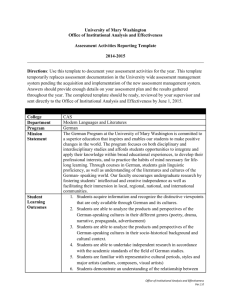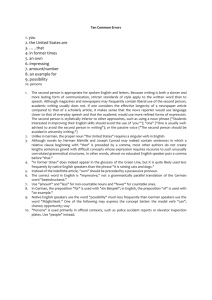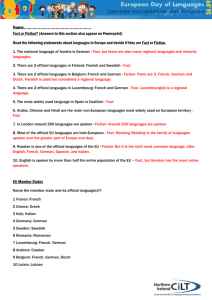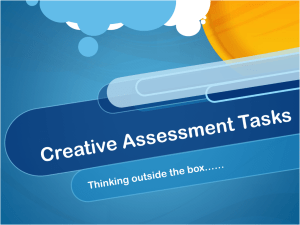German I
advertisement
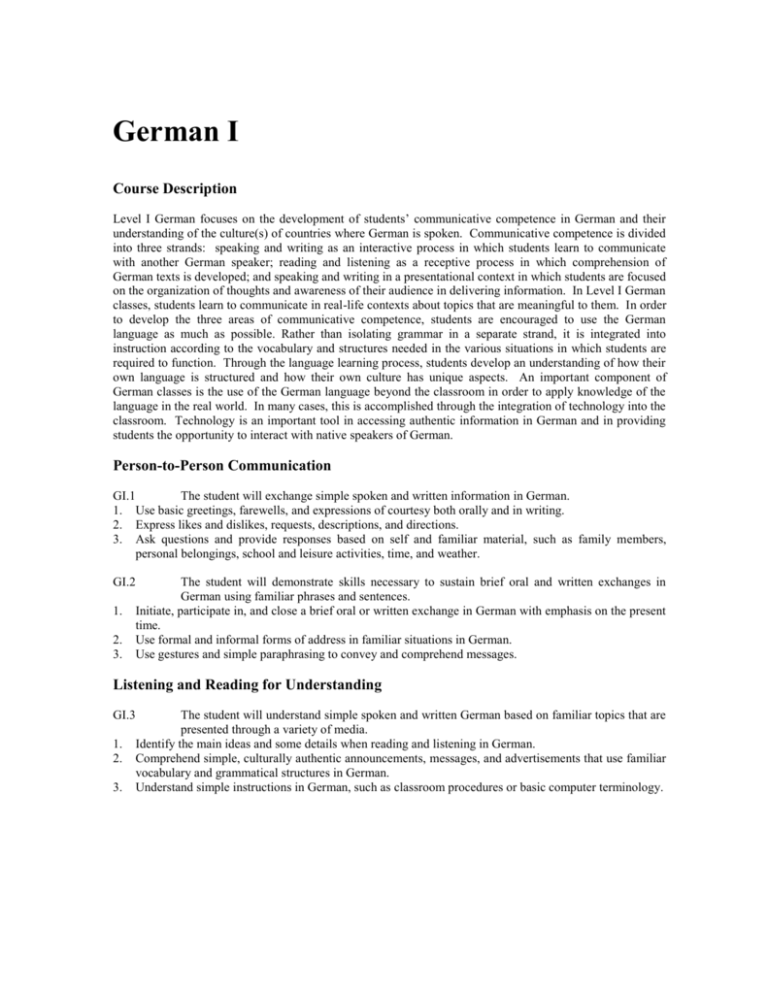
German I Course Description Level I German focuses on the development of students’ communicative competence in German and their understanding of the culture(s) of countries where German is spoken. Communicative competence is divided into three strands: speaking and writing as an interactive process in which students learn to communicate with another German speaker; reading and listening as a receptive process in which comprehension of German texts is developed; and speaking and writing in a presentational context in which students are focused on the organization of thoughts and awareness of their audience in delivering information. In Level I German classes, students learn to communicate in real-life contexts about topics that are meaningful to them. In order to develop the three areas of communicative competence, students are encouraged to use the German language as much as possible. Rather than isolating grammar in a separate strand, it is integrated into instruction according to the vocabulary and structures needed in the various situations in which students are required to function. Through the language learning process, students develop an understanding of how their own language is structured and how their own culture has unique aspects. An important component of German classes is the use of the German language beyond the classroom in order to apply knowledge of the language in the real world. In many cases, this is accomplished through the integration of technology into the classroom. Technology is an important tool in accessing authentic information in German and in providing students the opportunity to interact with native speakers of German. Person-to-Person Communication GI.1 The student will exchange simple spoken and written information in German. 1. Use basic greetings, farewells, and expressions of courtesy both orally and in writing. 2. Express likes and dislikes, requests, descriptions, and directions. 3. Ask questions and provide responses based on self and familiar material, such as family members, personal belongings, school and leisure activities, time, and weather. GI.2 1. 2. 3. The student will demonstrate skills necessary to sustain brief oral and written exchanges in German using familiar phrases and sentences. Initiate, participate in, and close a brief oral or written exchange in German with emphasis on the present time. Use formal and informal forms of address in familiar situations in German. Use gestures and simple paraphrasing to convey and comprehend messages. Listening and Reading for Understanding GI.3 1. 2. 3. The student will understand simple spoken and written German based on familiar topics that are presented through a variety of media. Identify the main ideas and some details when reading and listening in German. Comprehend simple, culturally authentic announcements, messages, and advertisements that use familiar vocabulary and grammatical structures in German. Understand simple instructions in German, such as classroom procedures or basic computer terminology. GI.4 1. 2. The student will use verbal and non-verbal cues to understand simple spoken and written messages in German. Differentiate among statements, questions, and exclamations. Use basic gestures, body language, and intonation to clarify the message. Oral and Written Presentation GI.5 1. 2. 3. 4. The student will present orally and in writing information in German that contains a variety of familiar vocabulary, phrases, and structural patterns. Present in German information gathered from informal conversations, class presentations, interviews, readings, and/or a variety of media sources. Describe in German basic familiar information, such as self, family members and others, events, interests, school, recreational activities, and personal belongings with emphasis on control of the present tense. Demonstrate increasing attention to accuracy in intonation and pronunciation in German especially when presenting prepared material orally. Demonstrate increasing attention to accuracy in word order, punctuation, accents and other diacritical marks, and spelling when writing in German. GI.6 1. 2. The student will present rehearsed material in German, including brief narratives, monologues, dialogues, poetry, and/or songs. Use appropriate verbal and nonverbal techniques, such as voice inflection, gestures, and facial expression. Communicate ideas in an organized manner using appropriate visual and/or technological support. Cultural Perspectives, Practices, and Products GI.7 1. 2. 3. 4. The student will develop an awareness of perspectives, practices, and products of Germanspeaking cultures. Identify some viewpoints of German-speaking cultures, such as those relating to time, education, transportation, and the role of family members. Identify some customs and traditions of German-speaking cultures, such as greetings, celebrations, holiday practices, and forms of address that demonstrate politeness. Identify some historical and contemporary individuals associated with important events from Germanspeaking cultures. Identify some products of German-speaking cultures, such as natural and manufactured items, creative and fine arts, recreation and pastimes, dwellings, language, and symbols. GI.8 1. 2. The student will recognize that perspectives, practices and products of German-speaking cultures are interrelated. Recognize that German-speaking cultures are shaped by viewpoints, customs/traditions, and products of speakers of German, such as the concept of Schultuete, Stammtisch, family celebrations, and typical foods. Identify major cities and geographical features and why they are significant in German-speaking cultures. Making Connections through Language GI.9 1. 2. The student will recognize how information acquired in the study of German and information acquired in other subjects reinforce one another. Identify examples of vocabulary, phrases, proverbs, and symbols from the German language that are used in other subjects. Relate content from other subject areas to topics discussed in the German class, such as current events from German-speaking countries or the influence of German-speaking explorers and settlers on various regions of the United States. Cultural and Linguistic Comparisons GI.10 1. 2. 3. The student will demonstrate an understanding of the significance of culture through comparisons between German-speaking cultures and the cultures of the United States. Compare patterns of behavior and interaction in the United States with those of German-speaking societies. Demonstrate an awareness that social practices and personal interactions differ among cultures. Demonstrate an awareness of unique elements of the student’s own culture. GI.11 The student will compare basic elements of the German language to the English language. 1. Recognize differences in sound systems, writing systems, cognates, gender, and level-appropriate idioms. 2. Recognize basic sound distinctions and intonation patterns and their effect on communicating meaning. Communication across Communities GI.12 1. 2. The student will identify situations in which German language skills and cultural knowledge may be applied beyond the classroom setting for recreational, educational, and occupational purposes. Identify examples of the German language and the cultures of German-speaking countries that are evident in and through media, entertainment, and technology. Identify resources, such as individuals and organizations accessible through the community or the Internet, that provide basic cultural information about the German-speaking world.

